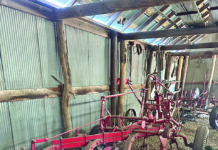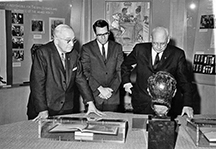Richard E. Shank
(shankr@prodigy.net)
Adding a John Deere 70 to the fleet of tractors at the Shank farm was not a part of the annual goals entering 2024, but fate intervened and there is one parked in a shed awaiting a makeover or what “tractor buffs” might call a restoration.
I guess one cannot go wrong owning a John Deere, a company that saw its origin in Grand Detour, Illinois, in 1837 with the invention of a new-fangled plow. In 1848, Deere moved his growing company to Moline, Illinois, and the business took off.
As tractors go, the John Deere 70 had a short three-year run from 1953-56. Still, more than 43,000 70s were manufactured and sold worldwide before being replaced by the Model 720. As the old-timers would say, it would take a three- bottom plow sailing across a field powered by its diesel or gasoline engine.
Across the nation, particularly in the mid-west, a few John Deere 70s are visible in fence rows or abandoned farmsteads. It makes one wonder why those tractor owners did not sell their old tractors for junk and market their farmsteads at the same time.
Collecting antique tractors has been dubbed everything from a hobby to a disease, and, perhaps, either term could apply.
My first antique tractor purchase was made in 1984, for a then 41-year-old Farmall H for what then seemed like a hefty sum of $875. The old Farmall is still a member of the Shank family of tractors and thanks to a paint job in 2023, it looks like it may have been on the showroom floor. These days, the H is still used for hauling tree limbs to spring toothing the garden. As my dad, who was a Farmall owner himself, used to say, “you can’t wear out a Farmall if you tried to.”
Following my first antique tractor purchase, I vowed it would be my last. As of today, I have added eight more to the collection, not counting the John Deere 70.
The latest acquisition does have some history worth repeating. Bill Riordan, a lifelong friend and high school classmate, spent a career employed by the Social Security Administration, and enjoyed working on the family’s farm in his spare time. Approximately 25 years ago, he purchased the John Deere 70 for use clearing brush and other duties on the Riordan farm.
Bill passed away in 2023 and his four children, who do not reside in the area, offered to sell me their dad’s old tractor. It goes without saying that I did not need another tractor, but still thought it might be fun to have one more to make the collection an even 10.
After using every known method to coax the 70 to run, my brother-in-law who was helping me, suggested we hook it up to his truck and tow it to the Shank farm.
The nine-mile trip to the farm was like something I had not done in a long time. As passing motorists gawked, they may have thought “what is that guy up to sitting atop an old John Deere tractor while being pulled across Saline County?”
Getting the tractor to start is a work in progress, but I am hopeful that a carburetor rebuild and a new ignition switch will do the job.
A friend asked me the other day how one finds parts for a seven decades old tractor and the answer is “very easily. ”Prairieland Partners can order practically any part one needs for a John Deere 70, from a seat cushion to an ignition switch.
Also, the antique collection hobby has produced a new industry of companies that offer after-market parts, including Steiner Tractor, headquartered in Lennon, Michigan.
Steiner is so appreciative of their customers that, each year, they send out a 732-page catalog of parts available for nine different tractor makes including everything from John Deere to Oliver, a defunct company whose last tractor rolled off the assembly line a half century ago. Calls to Steiner will result in quick service with sales representatives who seem more knowledgeable about my tractors than I do.
An ad on the back cover of the Steiner catalog states it’s motto: “Restore your old iron.”
After the tractor is running and receives a much-needed power washing to remove 70 years of dirt and grime, it will be driven up the road for a new paint job, before returning to the Shank farm.
Like most 70-year-olds, the John Deere 70 will never do another day’s work, but will be used for what we call “tinkering jobs,” a part of all farms.




